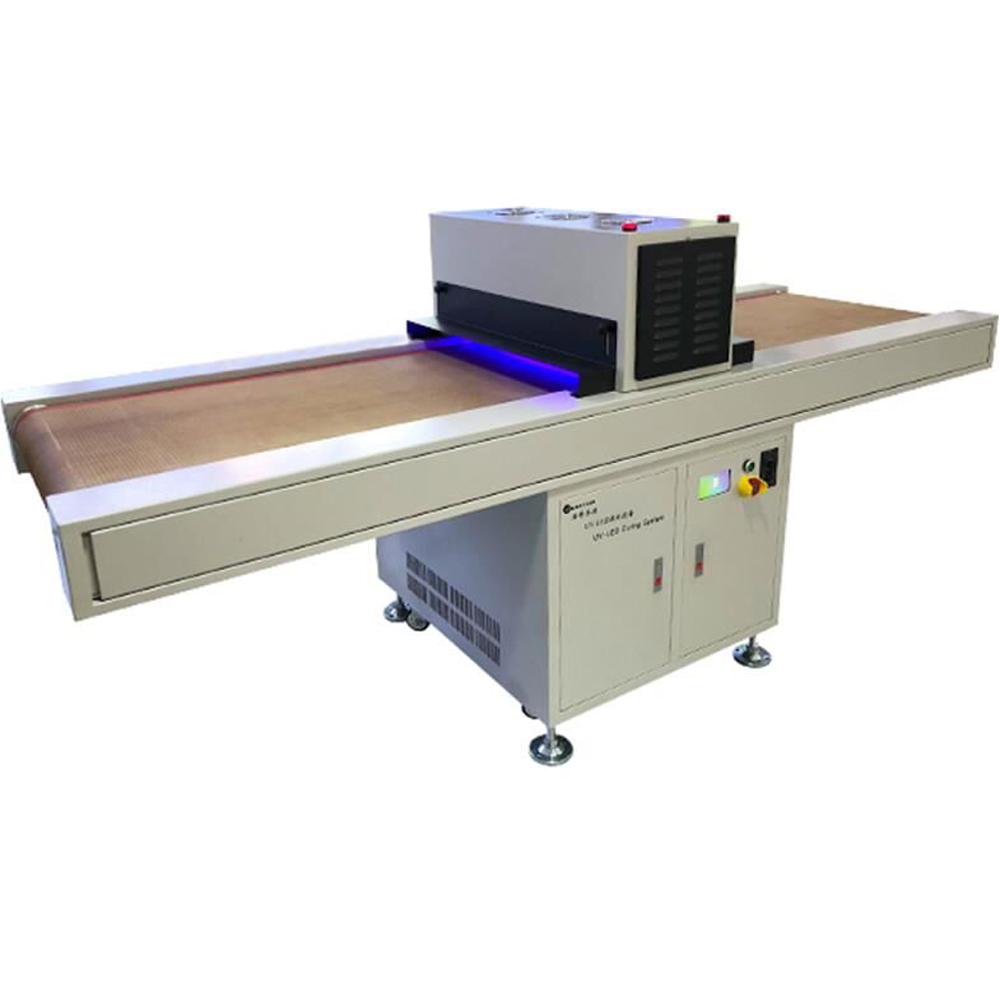

Printing is one of the four great inventions in China, with a history of thousands of years.With
the development of the printing industry, and the requirements of environmental protection are increasing,
a printing method using UVLED light emitting diodes as a curing light source has attracted more and more
attention from printing companies. This article discusses the characteristics of UV LED light source
curing equipment.
1. UVLED curing principle
Traditional UV printing refers to the photopolymerization initiator in UV ink. Under the irradiation
of UV light source, it absorbs ultraviolet light with different wavelengths and energy, and then reaches
the excited state to form radicals or ions. Then, the intermolecular energy transfer makes the prepolymer,
monomer, and polymer into an excited state, and a charge transfer complex is generated. The process of
continuous cross-linking polymerization between complex particles, and finally the ink is cured into a film
and adsorbed on the printed product.

UV LED (Light-Emitting Diode) light source is the product of the development of ultraviolet light
source technology towards more energy saving and environmental protection. It is a semiconductor
electronic component that can emit extremely narrow spectral half-width and can convert electrical energy
into light energy. The principle of photoelectric conversion is obtained by injecting a person on a
semiconductor substrate and doping impurities to grow a PN junction. The luminescence mechanism is due to
its electro-induced effect. The electrons and positive charges collide and transform into light energy
during the movement process. Its radiation peak is single, and the energy of light is concentrated in a
section of ultraviolet spectrum with effective curing effect. Because the half-width of the spectrum is much
narrower than traditional UV light sources, the energy is highly concentrated, the thermal energy is low,
and the irradiation is more uniform. Use UVLED light source can reduce the waste of printing resources and
the printing cost, thereby saving the production time of printing enterprises and greatly improving the
production efficiency of enterprises.
2.Advantages of UVLED printing
(1) Long life, traditional UV light source needs to be replaced after about 1500 hours of work. Frequent
replacement of light source parts may cause frequent failures of printing presses. At the same time, it
may reduce the efficiency of printing presses and affect the normal production of printing companies.
The service life of UV LED light sources can generally reach more than 20 times that of traditional UV
light sources, can reach 20,000 hours, and is not affected by the number of switching cycles. According
to its light-emitting principle, UV LED light sources can only be energized in one direction and forward
biased. When the current passes, electrons and holes recombine within them to emit light, ensuring the
stability of the light source and causing its light source decay rate much smaller.

(2)It has wider adaptability. The traditional UV light source has a large amount of heat and the printing
material is easily deformed by heat. The UV LED is a cold light source that emits a single wavelength,
does not contain infrared light, and has no thermal radiation. It does not generate much heat. Therefore,
the use of UV LED light source can significantly reduce the heat generated during the curing process,
and will not damage the appearance of the substrate. For example, heat-sensitive film substrates that
cannot be printed well on traditional UV equipment can print well on UVLED printing methods. Nowadays,
the rapid development of label printing, the printing speed is getting faster and faster, and the printing
substrate is getting thinner and thinner. If the heat is too high, the substrate will react when heated,
causing it to wrinkle, affecting the quality of the product. The use of UV LED printing can greatly reduce
the defective rate of the product and ensure that the task is completed within the printing period.
(3)Save energy. For traditional UV printing, the lighting system should be turned on for preheating
before printing. The stronger the light power, the longer the waiting time. In order not to delay the
printing period and maintain the service life of UV lamps, some printing companies often choose not to
turn off the irradiation system to keep the irradiation state, causing a lot of waste of light sources.
According to its own structural characteristics, the UV LED light source instantly converts electrical
energy into light energy and can be started at low voltage, so it can reach the maximum power output
without preheating time. More than 80% of the light source energy in its curing light source is used for
ink curing. At the same time, the luminous brightness is low, and the calorific value is small. Turning
on a very low light intensity can achieve the same curing effect of traditional UV light sources, which
can reduce power consumption by 70% to 80%. High energy efficiency. It can also be turned off when not
needed, further reducing energy consumption and costs.

(4)Protect the environment, and now the market share of UV printing in the printing industry has
increased significantly. Some printing companies are still using high-pressure mercury lamps as
their UV curing light source. After the printing factory is finished, it needs to spend human and
financial resources to dispose of the mercury it emits. If it is not handled in time, it will
penetrate into the surrounding environment. The mercury content in the discharged wastewater is very
low, which will not directly cause harm to the human body; however, the microorganisms inside can
absorb mercury compounds and transfer through the food chain, and eventually be absorbed and
accumulated by seafood such as fish and shrimp. Mercury is transformed and excreted very slowly in
the body and can be stored for a long time. If you eat this kind of seafood by mistake, it will
seriously affect your health. The UV LED lighting system is free of harmful chemical elements such
as mercury, and will not cause any impact on the environment and humans when working.